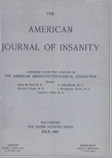Abstract
1. Experiments are briefly cited in which in narcotized cats, the hypothalamus was stimulated and the contraction of the nictitating membrane on the same side recorded. In addition to this the cephalad end of the cervical sympathetic was stimulated on the contralateral side, and the contractions of the corresponding nictitating membrane were recorded also. This preparation allows one to distinguish between central and peripheral effects. It was shown that anoxia, inhalation of excess carbon dioxide and various convulsant drugs, such as metrazol, coramine, picrotoxin and coriamyrtin, increase the excitability of sympathetic hypothalamic centers on intravenous injection. The most effective drug is metrazol, which may produce signs of increased sympathetic discharges as measured by the height of the contraction of the nictitating membrane for long periods of time.
2. The effects of anoxia and of metrazol convulsions were investigated on normal rats and animals in which the adrenals had been removed. Furthermore, rats were used in which, in addition to the removal of the adrenals, the vagi had been divided below the diaphragm. It was found that anoxia and metrazol, while producing a hyperglycemia in the normal animal, lower the blood sugar level in the adrenalectomized rat. If, however, the vagi are divided in adrenalectomized animals, anoxia and metrazol no longer produce a hypoglycemia, but call forth merely a slight and delayed rise in blood sugar. The experiments are interpretated to mean that anoxia and metrazol produce a simultaneous excitation of the sympathetico-adrenal and vago-insulin system in the normal animal, but that the excitation of the latter does not become apparent on account of the predominance of the sympatheticoadrenal system.
3. It is shown that electrical excitation of the hypothalamus leading to a typical rage response produces a rise in the blood sugar in the normal, but a fall in blood sugar in animals with adrenals eliminated and liver denervated. If, however, the vagi are cut, the hypoglycemic effect disappears and a delayed slight hyperglycemia (due to sympathin?) occurs. It is inferred that the process of sham rage is characterized by a simultaneous discharge over both divisions of the autonomic nervous system.
4. If cats in which the spinal cord had been divided at the sixth cervical segment, in order to eliminate excitation of the sympathetico-adrenal system, are exposed to a barking dog they react with reversible hypoglycemia. This reaction is absent when the vagi are cut below the diaphragm. It is inferred that emotion involves both vagal and sympathetic excitation. The former leads to increased secretion of insulin, the latter enhances the secretion of adrenalin.

